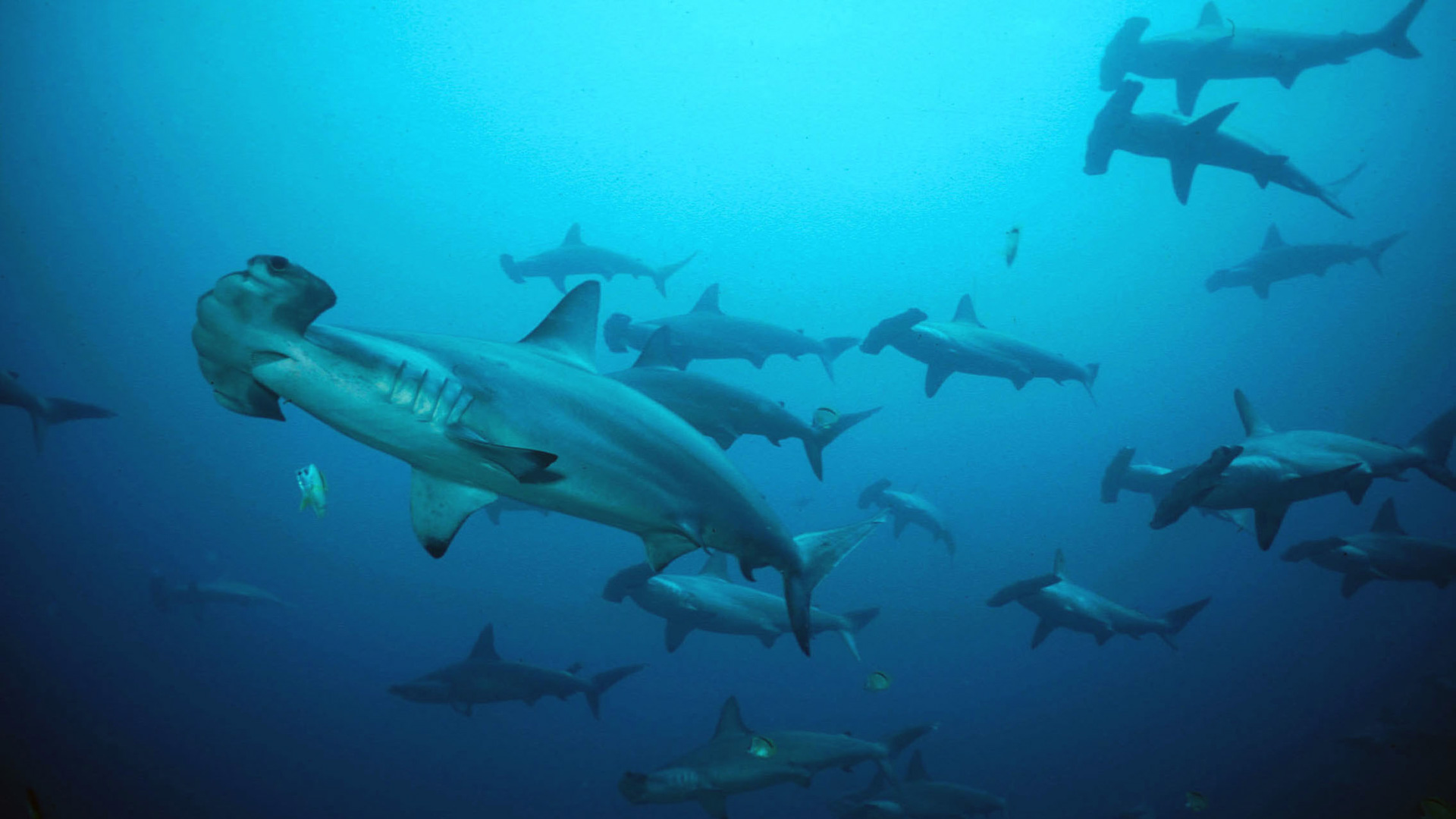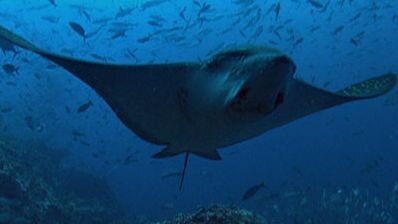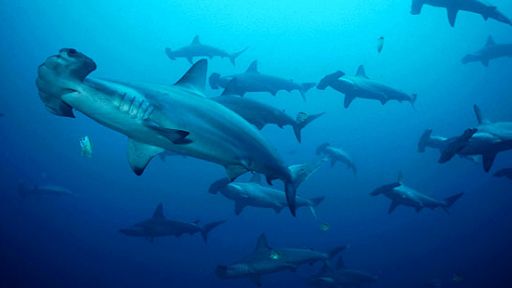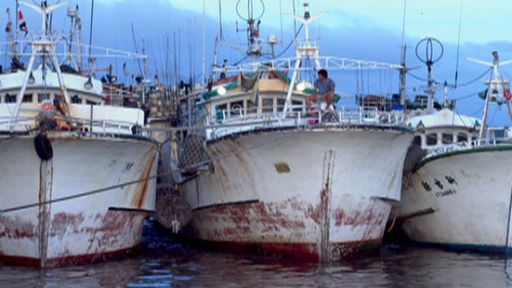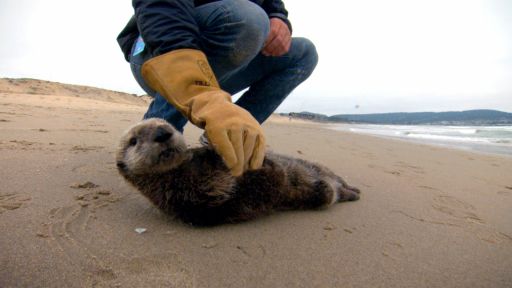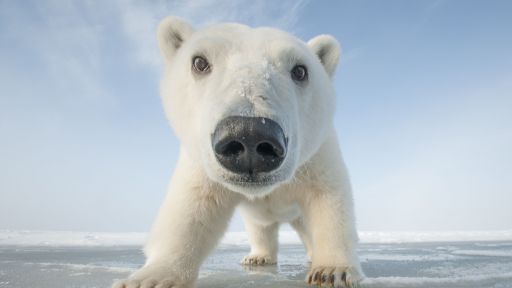TRANSCRIPT
[majestic music] - [Narrator] Thousands of sharks.
Silkies, whitetips, hammerheads hunt along the volcanic reefs of this tiny island in the Pacific.
[upbeat music] Acclaimed filmmaker Howard Hall and his crew have been diving at Cocos Island for more than a decade.
- [Diver] No, this may not be [indistinct].
- Whoo!
Look at those big boys.
- There's 50 sharks down there.
- Go.
- Yeah, go.
Yeah, go.
- Go.
- Push him in.
- [Narrator] It takes all of their experience and knowledge to dive in these treacherous waters.
Welcome to Shark Mountain.
[mellow music] [gentle music] The beach, San Diego, California.
This is the edge of our world.
Along this thin line, America slips quietly into the vast Pacific Ocean.
[gentle music] It's no place for humans out here, but it calls to us all the same.
Yet only 1% of the ocean has truly been explored.
[gentle music] Just an extraordinary few have risked its dangers and delved into its mysteries.
Two of them are Howard and Michele Hall.
Their hours underwater in the most remote places on Earth add up to years.
After more than 50 films, they're considered the best in the business.
- [Michele] Right, we'll arrive on Wednesday night.
- [Narrator] But even for pros, the work of exploring begins on the phone.
- At night and head out to Costa Rica the next day.
Right, three weeks.
Three weeks of diving.
No, no.
I never said two weeks.
It's always been three weeks.
- [Narrator] As Michele tackles the logistics, Howard organizes the gear, and he never travels light.
Two cameras and nearly 40 cases of equipment must all be packed and shipped to one remote location or another.
But lately he's been finding that no place is quite as remote as it used to be.
- You know, there's really no place on the planet that's not being affected in some way by human population growth.
So we feel like we're sort of on a quest to discover as much as we can, learn as much as we can about the marine environment, and capture this beautiful wilderness on video tape while we still can.
We understand that we're sort of the privileged few that get to go there and see these things firsthand, and it's wonderful, and being able to share that with the rest of the world, we think that's important.
- [Narrator] This time, Howard and Michele have agreed to show us how they do it.
[bright music] They've chosen a special spot, a tiny outpost 300 miles into the Pacific off the coast of Central America, Cocos Island.
Cocos was once the haunt of pirates.
Now, Howard and Michele are seeking their own brand of treasure.
Cocos is world famous for sharks.
[dramatic music] - [Howard] Cocos is a bit like Conan Doyle's "Lost World."
Not the island itself, but just beneath the waves.
[bright music] In an age where 90% of the large fish have been taken from the sea, you can still come to Cocos and find the ocean like it used to be.
Hundreds, even thousands of sharks gather in the currents around the island.
There's no place like it in the world.
[lively music] For some 10 weeks of filming, our home will be the research vessel, Undersea Hunter.
It's a comfortable boat, but you'd better be good friends with your crew.
Besides, your life depends on them.
25 years ago, Bob Cranston and I began filming sharks together off the California coast.
He's been with me ever since.
His diving and camera skills are extraordinary.
Peter Kragh spent years as a dive master in these waters and knows the treacherous currents that sweep past the island.
I'll be relying on Peter to keep us out of trouble.
Michele seems an improbable undersea explorer.
At barely 100 pounds, she's undersized for the heavy diving gear she must carry.
In addition to organizing our expeditions, Michele is a talented underwater still photographer and marine naturalist.
[majestic music] - [Narrator] Ocean life is so rich at Cocos that the island and a 12-mile zone all around it has been designated a Costa Rican national park and World Heritage Site.
No fishing is permitted here.
[majestic music] Many of the large animals at Cocos are visitors, but most of the smaller species are permanent residents, like this pair of courting pufferfish.
[majestic music] Another resident, this blue-spotted jawfish, seldom ventures far from her den.
Ocean currents bring her everything she needs.
[bright music] Because of these currents, almost every inch here is covered with life, and that makes Cocos both spectacular and dangerous.
[majestic music] - [Howard] Hey, Cranston, you oughta look behind you.
Take a look behind you.
Yeah!
[majestic music] This is why divers come to Cocos.
Often when I'm looking down at some small creature, a shadow is suddenly cast over the reef.
A chill always goes down my spine before I raise my head to discover legions of hammerhead sharks passing overhead in schools so dense they blot out the sun.
It's an experience that goes beyond awe.
It's magical.
[majestic music] [water lapping] - [Narrator] Howard and his crew don't rely on ordinary scuba here.
Instead, they use a more sophisticated system that emits no bubbles and won't run out of air.
- This is the diving gear we'll be using for the film.
It's very different than standard scuba equipment.
This is a closed-circuit mixed-gas rebreather, and it's very similar to the systems the astronauts use when they're in outer space.
Basically it takes the gas that you're breathing, purifies it and recycles it, and then you just rebreathe it, hence the name rebreather.
This thing makes filming wildlife much more efficient underwater.
It's very, very silent.
It allows you to get closer to the marine life, and you can stay down for very long periods of time.
- Besides it's got communications in it.
So this is the push-to-talk.
Kind of like talking with a bunch of marbles in your mouth, but Howard can understand me, I can easily understand him.
Nobody can understand us.
- [Bob] Hey, Howard, are you out of here?
- [Howard] I'm out of here.
I want to live to dive another day.
Exactly.
And that's it.
- [Narrator] Cocos lies directly in the path of deep ocean currents.
Their collision with the island can churn the waters into an undersea storm.
[boat engine roaring] - [Howard] The currents around Cocos behave a lot like turbulent winds.
[boat engine roaring] Even when the surface is calm, the currents below can be unpredictable and dangerous, threatening to sweep us far out to sea.
[boat engine humming] But there's no way around it.
The most exciting dives are usually where the currents are most treacherous.
[boat engine roaring] The only way to test these waters is to jump in.
[ethereal music] If we're able to work in the current, we might stay down for two or three hours at a time, or as long as our camera batteries last.
Current is often our nemesis, but it's also our guide to the most spectacular animals.
[majestic music] - [Narrator] Eagle rays fly over the reef.
But to feed, they drop down on the deep sandy plain and scan for animals hidden beneath the surface.
To film them, Howard stops swimming and starts walking.
- [Howard] I often take my fins off while filming animals in the sand.
When I leave my fins on, I risk ruining the shot by kicking up big clouds of silt and sand.
And then you'd never see how this ray makes a living.
- [Narrator] Rays and sharks are close cousins and share the same sensory abilities.
They both detect the electric fields produced by living things.
It's this special sense that allows sharks to find prey in total darkness, or hiding beneath the sand if they pass close enough.
The peacock flounder's camouflage won't work unless it keeps perfectly still.
But camouflage helps the flounder ambush its own tiny prey.
[gentle music] These whitetip sharks are simply resting here on the bottom, but when they hunt, extraordinary senses come into play.
Their vision is pretty good in low light, but their sense of smell is far more powerful.
They can also track prey moving in the water by following subtle changes in water pressure.
The tiny spots on his face are organs that can sense minute electrical fields generated by the twitch of a prey animal's muscle.
But not everything interesting here is a shark.
- [Howard] Well, this little guy wasn't on my agenda, but it's certainly one of the strangest I've ever seen.
Everything about this fish is just, well, weird.
It's a red-lipped batfish.
Instead of really swimming, it walks on fins modified to work like feet.
It also has a strange horn on its head, which conceals an odd lure.
How it uses this lure is not really known.
This is the weird-looking fish I was hoping to find.
It's a frogfish pretending to be a harmless orange sponge.
Like the batfish, it uses its fins more like feet.
To move in for closeups, I bring a heavy tripod to keep the camera steady.
The frogfish is waiting patiently to deploy its second trick of deception.
It attracts prey with a tiny lure it uses like a fishing pole attached to the top of its head.
While Michele and I are hoping something will happen, Bob discovers some real action about a quarter mile away.
- [Bob] Hey, Howard, you better get out here.
The whitetip reef sharks are interesting.
- [Howard] Say it again.
- [Bob] I got whitetip courtship behavior here.
[mellow music] - [Howard] [indistinct] what's going on?
- [Bob] I think there's going to be some mating going on.
The males are chasing the females.
Over.
- [Howard] Where are you?
Where are you?
- [Bob] 80 feet off the point.
You better get out here.
You're gonna miss it.
I've never seen anything like it.
The males have got the female and she's in the middle and [indistinct].
- [Howard] I'm coming.
- [Bob] Just get out here.
- [Howard] Okay, I'm coming.
[upbeat music] A swarm of male whitetip sharks were attacking a single exhausted female.
It's one of the most violent courtships in the animal kingdom.
[intense music] Male sharks have to hold on while they mate.
They can only do that with their mouths.
[dramatic music] So they bite the female on the gills or pectoral fin.
In no time, the female's gills are lacerated.
[dramatic music] In 35 years of observing and filming sharks, I've seen courtship behavior only four times, and never have I seen the entire act, start to finish, and at such close range.
It was unbelievably violent and brutal.
When it's over, the female swims away, exhausted and bleeding.
[gentle music] - [Narrator] Above the water, Cocos seems a more peaceful place.
Seabirds nest on the island by the thousands.
There are no natural predators here to disturb them.
The fairy tern wastes no energy building elaborate nests.
Instead, she lays her single delicate egg on a round tree branch.
It's an incredible balancing act.
The slightest mistake, and the egg will fall.
[birds calling] Brown boobies prefer to nest on the ground where gravity is less likely to cause a tragic mishap.
And the red-footed booby prefers to make crude nests in low-growing trees, where they raise down-covered chicks.
But this idyllic island life is only half the story.
All these birds make their living from the sea where they are eager players in a truly violent event.
Howard and his crew call it a bait ball feeding frenzy.
Beneath the diving birds, predators herd a school of green jacks and triggerfish into a tight ball and then pin them against the surface.
The fish are attacked from above and below.
[dramatic music] The crew takes turns on lookout for birds beginning to gather.
When they see birds diving in to feed, they have to move fast.
A bait ball frenzy doesn't last long.
- It's pretty good, Howard, they're still there.
- Okay, slow down a little bit.
Slow down.
We don't wanna be too close.
Okay cut the power.
Let's go in here [indistinct].
Let's go.
[dramatic music] Silkies and blacktip sharks cut through the school, devouring fish as fast as they can.
Yellowfin tuna streak in like missiles, attacking at incredible speed.
[dramatic music] And bottlenose dolphins gather by the dozen.
The buzzing sounds of their echolocation fills the water.
[dramatic music] We hang back, careful not to get too close to the frenzy and risk being attacked by the sharks.
Many of the jacks are injured and bleeding, and that only intensifies the sharks' excitement.
Fish gather around anything that might serve as refuge.
They even gather around the sharks themselves.
Some fish begin gathering around us.
It's not a good thing.
Injured triggerfish begin following Michele.
Then they surround Bob, seeking a place to hide from the sharks.
He can't get rid of them.
Anything reflective could be mistaken by a shark for an injured fish.
Suddenly it's become dangerous.
But just as suddenly, the bait ball breaks up.
The school of fish is gone.
Pretty equal mix.
Dolphins, yellowfin tuna, silky sharks, blacktip sharks.
And the poor little fish.
Live fast, die young.
Man, the whole bait ball is gone in about 10 minutes.
You jump in, it's there, and you can actually see it getting smaller and smaller and smaller, especially with the tuna.
The tuna are the fastest predators out there.
They just go through it like a meat grinder.
- Howard, I didn't like that at all.
All those fish came right around my head.
I was slapping them off like this.
Sharks came right by my ear.
I could feel them.
I think I got hit by one.
Next time I'm wear a hood.
[gentle music] - [Narrator] The weather at Cocos is as turbulent as the sea.
[gentle music] [water whooshing] Beneath the surface, strong ocean currents play the part of wind and rain.
[water whooshing] As the currents collide with undersea escarpments, they rise and swirl around the island.
- [Howard] We often struggle against a current flowing north at the surface, only to struggle against one flowing south on the bottom.
But hammerheads hover like birds of prey on a mountain wind.
And marble stingrays soar the current like living hang gliders.
- [Narrator] The currents also cause optical problems for the crew.
As dense cold waters rise and mix with surface layers 10 to 15 degrees warmer, they create a strange heat haze effect.
- [Howard] It's like diving in a mixture of oil and vinegar.
Images blur, making camera work impossible as animals move through the mixing layers.
- [Narrator] But it's current that brings life to Cocos.
Garden eels never leave their burrows.
They rely on current to deliver drifting platonic prey.
The plankton, nourished by this cold, nutrient-rich water, is food for many species of fish here.
[gentle music] As well as some of the ocean's most spectacular leviathans.
The manta ray.
[majestic music] The whale shark.
[majestic music] The island's reefs provide another place for fish to feed.
Schools of moorish idols swim over the reef, feeding on tiny sponges.
[majestic music] A hawksbill turtle grazes on algae that clings to the rocks.
Her hard shell protects her from most species of sharks, and the whitetips show no interest.
[water lapping] - [Howard] The hawksbill finds a sea cucumber to eat.
To me, it seems even less appetizing than algae.
A sea cucumber has the consistency of rubber.
And I suspect it doesn't taste much better.
But the turtle seems to like it.
Suddenly I find myself being pulled away.
The current has struck again.
- [Bob] Come on, Howard.
Swim over there and light the turtle.
- [Howard] The boat anchor has broken loose from the reef, pulling the movie light cable off station, and me along with it.
The turtle doesn't much care.
Of course, the turtle doesn't care.
Naturally, by the time I secured the cables, the turtle had finished its meal and decided to leave.
Typical.
Fortunately, Bob was there to get the last shot as the turtle ascended through a school of hammerheads.
[ethereal music] [water lapping] [rain splattering] - [Narrator] The film crew is fond of saying that there are only two kinds of weather at Cocos.
Either it's raining or it's about to.
The island receives more than 24 feet of rain each year.
- Oh, man.
It's getting wet faster than it's coming in.
[Howard laughs] This one can get out.
- There's water, so you're getting wet before you even get in the water.
[thunder crashes] Okay, I think this towel's not doing much anymore.
It's pretty saturated.
- Okay, you all set?
- I'm set.
We've been coming to Cocos for 10 years now, and despite all our experience and preparation, the work's not getting any easier.
- I know this place gets 24 feet of rain a year, but I don't know why it has to all come down the same day.
- 'Cause we're here.
I think all this mud'll drift away in the...
The fact is, some of the creatures we've always counted on here are becoming much harder to find.
Cocos is changing, and I'm beginning to worry about it.
[rain splattering] [dramatic music] But there is one sequence that I'm sure we can get, something that still happens every night on the reef.
- [Narrator] Night is when sharks go hunting.
Howard is determined to film whitetips working the reef.
- [Michele] Did you see some action down there, Peter?
- [Peter] There were silkies right behind the boat.
- Oh, the silkies.
- Yep.
- So it's not just whitetips tonight.
[metal clangs] Oh, what happened?
Oh!
[laughs] - Everybody to the rescue.
- Man, well!
[laughs] - Michele, you just wanna secure the tank here.
[Michele laughing] - I need help.
[laughs] - You know, with a little luck, this is gonna be on television.
- It's a typical night dive.
- Oh, man.
- Hold still, hold still.
- I hope the rest of the night goes better than this.
- Just hold still.
Okay, there you go.
- [Michele] By the time we were ready, I was shocked to see how many large silky sharks had gathered beneath the boat.
- I see at least seven of them here right now.
- Ooh, look at those big boys.
- Oh, man.
Look at the size of that guy.
Now, this may not be entirely safe.
- Well, if we jump in and just descend right away, hopefully they won't follow us.
- I don't think you wanna stay on the surface any longer than possible.
- Yeah.
Okay.
- When we start spashing, they're probably gonna come in like crazy.
- Go.
- Yeah, yeah, go.
Yeah, go.
- I know!
- Go!
- Go?
- [Howard] Yeah, we're thinking about it.
- [Bob] Go.
Push 'em in, Peter.
[eerie music] - [Michele] I'm terrified!
I'm terrified.
[eerie music] I didn't like that.
- [Bob] Thought you guys were going diving.
- Those silkies scared me out the water.
I've never been scared out of the water like that before.
- [Peter] This was like a bait ball without the bait.
- They were knocking into my feet.
Knocking my leg.
I wasn't sure at first, I thought it was Howard kicking me.
- Oh, man.
- It just was pushing, but- - There's a lot of sharks down there.
- It all finally cleared, and it wasn't Howard kicking me.
It was the silkies knocking into me.
- There's 50 sharks down there.
I'm not talking about whitetips.
I'm talking about the big guys.
- Yeah.
I don't think we're gonna do this tonight.
- Michele, could you kind of crawl out of the way?
- [Michele] I'm trying.
[laughs] Sometimes we use bait to attract sharks, but we never once used bait while making this film, and certainly not at night.
So I don't know why these sharks were so aggressive.
That's what really freaked me out.
I know that Howard will want to try this night dive again.
I'm really not looking forward to it.
[gentle music] - [Narrator] The next day, they tried filming animals a bit less threatening than sharks.
- [Howard] One of our goals was to develop a time lapse system for capturing high-definition images of animals that move very slowly in real time.
The system was developed largely by Peter, and this will be our first dive to test the camera.
At normal viewing speeds, these cushion sea stars seem about as alive as the rocks they cling to.
But in fact, they are moving.
If we get this right, you'll see that these animals exhibit some interesting behavior, and even some character.
[water gurgling] It's all set up.
Now, we just wait.
When we speed up the action, you can see that these animals have a lot of personality.
They twist, bend, and even glide over the reef.
Cushion stars feed mainly on algae, and we've discovered that they graze across the sand in a very organized way.
They form a front that's continually on the march.
But some of the stars appear to be injured.
I couldn't imagine what might eat a cushion star.
They're about as tough as an old tennis shoe.
[water gurgling] Then as we explored some small caves, we saw lobsters approaching a cushion star.
At first, they were scared off by a shark swimming overhead.
But it soon became clear what was happening.
Lobsters are nocturnal.
During the day, they stay close to their dens.
They may be afraid to venture out for something more interesting to eat, so they pick up a cushion star and start gnawing on the legs.
The lobsters seldom finish their meal since the cushion star is so tough, and so the stars survive with only some minor leg damage.
- [Narrator] And cushion stars aren't the only daytime snack the lobsters indulge in.
It turns out the lobsters will also feed on venomous sea urchins.
Eating an urchin isn't easy.
The lobster has to carefully break off the poisonous spines before feeding on the tasty meat inside.
[gentle music] Most underwater animals have more respect for urchins.
Baby cardinal fish are hiding in this forest of spines for protection for predators.
But in this world, no defense is perfect.
Leather bass have their own clever tactic.
Several attack one side of this urchin cluster, driving the cardinal fish into the waiting mouths of leather bass on the other side.
Then they return the favor, and all the leather bass get something to eat.
[bright music] But a brush with urchin spines is trouble for Howard.
[dramatic music] - [Bob] What's the matter, Howard?
- The sting from an urchin burns like fire.
It hurts like the devil for 10 minutes or so and leaves a mark on your skin that can last for months.
It's a little humbling to see a hogfish tackle an urchin so easily.
They're completely immune to the venom.
[gentle music] The motto on the reef is often thought to be eat or be eaten.
And though predation is a big part of what happens down here, it's far from the whole story.
[majestic music] Life down here is amazingly complicated, and sometimes surprisingly gentle.
We've observed that courtship between male and female is seldom limited to the simple act of mating.
Bigeye jacks pair up every evening and swim together for hours.
They signal that they're a pair by displaying contrasting colors.
And these more gentle behaviors even extend to relationships between species.
Courting jacks descend to the reef and are met by yellow barberfish.
Although barberfish are perfect size prey for the jacks, no predation takes place.
Instead, the barberfish pluck parasites from the jacks.
Even the fiercest predators of Cocos will engage in gentle cleaning.
[gentle music] Moray eels like to be clean too, though it can be a bit uncomfortable.
An alternate method of removing parasites is to use a rubbing rock.
And if no rubbing rock is handy, a turtle shell will do.
But not all of this behavior is so easy to understand.
And at this very ordinary looking rock, a real Cocos mystery plays out.
The spectacular silvertip shark, a rare species here, comes to this single rock to be cleaned by tiny rainbow wrasse.
The wrasse are everywhere, but the silvertips only visit them here.
Why the silvertips at Cocos come to this one rock and nowhere else is a complete unknown.
[gentle music] Silvertips were never common here, but in recent years, the numbers of all sharks seem to have declined.
The cause hangs from the mouth of this silky shark.
It's a long line hook, a dark harbinger for the future of Cocos.
[dramatic music] - [Narrator] Fishing boats have anchored at Cocos.
Fishing is illegal for a 12-mile zone all around the island.
The 12 miles is just a two-hour swim for a migrating shark.
These boats and others like them kill dozens of sharks every day.
But Howard's work continues.
He and the team have just one more week to capture the story of Cocos.
[water gurgling] [gentle music] As evening approaches, this male peacock flounder abandons his camouflage.
He risks exposure as he swims across the reef towards the sandy plain.
He's looking for love.
[gentle music] Once he spots a female, he begins an elaborate courtship that lasts more than 30 minutes.
[gentle music] When she's ready, the female will follow the male up toward the surface.
[majestic music] At the top of their ascent, they simultaneously release their spawn.
[majestic music] Capturing the courtship of large marble stingrays is like filming a ballet.
[gentle music] - The dance of the marble rays is certainly the most beautiful courtship we see at Cocos.
Dozens of males pursue a single large female.
Most of the time, she wants nothing to do with her gaggle of suitors.
[dramatic music] When she stops, the males hover overhead, surrounding Bob and me.
[gentle music] We're careful with these animals.
The tail of each ray is armed with a venomous stinger nearly eight inches long.
[gentle music] Constantly bumped and nibbled at by the anxious males, the female begins moving again.
The procession resumes, gliding gracefully over the reef.
[majestic music] Occasionally the female will double back, trying to throw her followers off the trail.
Once it starts, this behavior can go on for days.
I've witnessed this graceful display many times at Cocos, but how these gatherings culminate has always eluded me.
[flags flapping] [water lapping] I'd like to get one really good shot of that female leaving.
I was actually just [indistinct].
- Think the marble rays gonna be there tomorrow?
- I hope so.
I'd love to see actually what the mating looks like 'cause I've never seen that.
All the time we've seen the marble rays, you know, doing these aggregations, and you notice the males will come up off the bottom.
When you're hovering up high, they come up like to investigate.
And I think maybe they think you're a female up there.
- Right.
Yeah.
- You know, and then they come up, and so it may be that the mating actually goes on near the surface.
So when she's ready, maybe she just ascends, and all the males come up.
I'm only guessing, though.
I've never seen, you know, the actual act.
- The guys at [indistinct] have seen it.
- [Howard] They've seen them.
Or they go?
- They've seen it.
Yeah.
The female comes up off the bottom, and the male come up underneath, belly to belly, and then insert their claspers in.
It's sort of like the whitetips.
Once one is done, the second one comes and takes over.
- Wow.
- And then- - [Howard] I'd love to see that.
Our time at Cocos is rapidly coming to an end, but there is one last dive we need to make, and I think we're ready.
[ethereal music] - Here we go.
Another night dive.
I don't know who invented the night dive.
And I don't know who invited all the sharks off the back end of the boat.
But I guess we're gonna go down and find out.
- [Michele] The silky sharks will probably stay high off the bottom.
There's no bait in the water, so there's no reason for these sharks to bite.
I just need to get down quickly, down to the bottom where it should be safe.
Okay.
Ready?
[eerie music] I feel much better when I see the glow of lights on the sand below.
The silky sharks are staying well above us now as Howard begins leading us across the sand and toward the reef.
- [Howard] When we reach the reef, we find it swarming with activity.
Hundreds of whitetip sharks are hunting like a pack of wolves.
No bait was used to cause this gathering.
Like the leather bass attacking cardinal fish in the urchin spines, these sharks have learned the advantage of hunting together.
There they go!
The sharks all seem to dive into the reef at once, but with each attack, only one shark emerges with a fish.
[dramatic music] Soon we begin to see a pattern emerge.
This pack strategy is more efficient than hunting alone.
Sleeping fish takes shelter in the reef.
In the darkness, the sharks only sense their prey if the sleeping fish moves.
Once a shark discovers a fish, it chases it deeper into the reef.
Other sharks immediately rush in.
If the first shark was alone, the fish might escape.
[eerie music] [dramatic music] But when the sharks hunt in a pack, the fish often blunders into the waiting jaws of another shark.
As a pack, the sharks are more successful.
[dramatic music] - [Michele] The fear I felt earlier seems a distant memory now.
I'm thrilled to witness a nightly drama unfold, just as it has for thousands of years before divers ever discovered this world.
You might think all this wildness would be safe, hidden away at this little island.
I only wish that were true.
- We're at the dock here in Puntarenas where the Undersea Hunter ties up between trips, and right next door is the Taiwanese fishing fleet.
You can see these long line fishing boats here.
There's probably 30 or 40 of them tied up at this particular dock.
And there's numerous other docks here in Costa Rica.
And it's all rather secret because they don't really want the bad publicity that comes with the outrage over shark fishing.
They recently put this wall up here so that people like us couldn't film the operation of them offloading the sharks and processing the sharks.
It's all sort of out of sight and therefore out of mind that this is where the sharks are going.
Every night these boats go out, set literally hundreds of miles of long lines, and the sharks that migrate up and down the coast of Costa Rica and migrate to and from Cocos Island have to run the gauntlet through these long lines.
And of course, many of them don't make it.
It's a very sad thing.
I think for filmmakers like myself, we're perhaps the last generation to see large numbers of sharks in the wild.
10 years ago, there were so many more sharks than there are now that it's really alarming.
And I know that 10 years from now, especially with the constantly increasing size of these fishing fleets, a cameraman's not gonna be able to come out to Costa Rica and film sharks.
They're just gonna be all gone.
[somber music] - [Narrator] For now, the sharks are still coming to their island outpost at Cocos.
- [Howard] You have to be in the right place at the right time.
- [Narrator] For 400 million years, sharks have been the ultimate survivors.
They've outlasted dinosaurs and ice ages, but humans will prove to be their greatest challenge.
Yet the deep ocean still offers them a chance, a refuge beyond our reach, a last retreat in its dark blue, mysterious depths.
[gentle music] [majestic music] [bright music]
